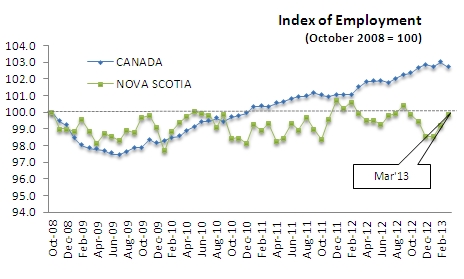For additional information relating to this article, please contact:
April 05, 2013LABOUR MARKET TRENDS MARCH 2013 TRENDSThroughout much of 2010 and 2011, Nova Scotia's seasonally adjusted employment results have been characterized by monthly volatility resulting from shifts in employment growth between full and part employment. In 2012, this volatility has been replaced by short trends; slow employment declines in spring of 2012, followed by three months of gains in the summer and three months of declines in the autumn. The latest employment results for March 2013 showed an increase of 2,900 in overall employment, the second month of substantial gains.

Source Statistics Canada Labour Force Survey
All March employment growth was among full-time workers (5,600) with a decline of 2,600 for part time employment. This continues a long pattern of full-time and part-time employment trade-offs.

Source Statistics Canada Labour Force Survey
The employment level for March is just below the peak level observed before the global recession (October 2008: 456,500). Canada has been above that level since the start of 2011.

Source Statistics Canada Labour Force Survey
Compared to February 2013, the labour force has increased by 3,900 (0.8 per cent) to 503,400. This increase in labour supply coupled with a smaller increase in demand (employment) increased Nova Scotia's seasonally adjusted unemployment rate by 0.2 percentage points to 9.5 per cent. With more workers in the labour force compared to February, the participation rate increased by 0.5 percentage points to 64.5 per cent.
Compared with March 2012, the labour force has increased by 4,900 (1.0 per cent) while employment has declined by 400 (-0.1 per cent). With an increase in labour supply along with a decline in employment, the net result is an increase in the seasonally adjusted unemployment rate from 8.5 per cent in March 2012 to 9.5 percent in March 2013.
Labour force levels in Nova Scotia are still near record highs – a labour force of 503,400 is the second highest monthly result on record (August 2012 was 504,700). In August of 1990, Nova Scotia had a labour force of 431,300 and a participation rate of 61.8 per cent. The latest participation rate was 64.5 per cent in March 2013.
Comparing the first quarter of 2013 with same period in 2012, there has been a decrease of -1.1 percent (4,800) in average employment levels. This reflects declines in both in full time employment (-2,900) and part time employment (-2,000).
During the first quarter of 2013, the labour force increased 0.9 per cent, compared with the same period in 2012. With employment declining coupled an increase in labour supply, the net result was an increase in the average unemployment rate from 8.4 per cent for the first quarter of 2012 to 9.5 per cent for the same period in 2013. The labour force participation rate remained the same at 64.1 per cent.

Source Statistics Canada Labour Force Survey